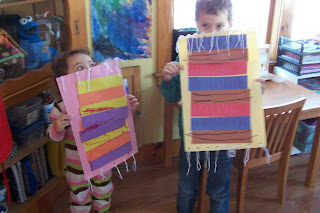-------------
4. Stop Cleaning The House and DO ART WITH YOUR KIDS! Specifically: Origami!
I constantly struggle with this one. I have a to-do list a mile long and when the kids are home, it seems as if I clean even more! When they are home on a snow day, I am mopping up puddles of melted snow, picking up four sets of snow boots (again and again!), hanging up snow pants to dry, making cocoa, getting snacks (again?!?), etc. etc. As the day goes on, I find myself getting more and more frustrated as I try to "get stuff done" while the children vie for my attention. So, my advice for you: stop cleaning and play.
Play dominoes, build a snow fort, make a yummy treat, sit and do a craft. The dishes will wait, the laundry will be there later. You'll be spending time with your kids and, let me tell you a secret, after you spend some time with them they MAY even run off and play and you'll have time to fold the laundry. Maybe. If not, you'll relax ad have a good time for a few minutes which is better than yelling "go play!" and fuming while you do the dishes.
One type of art that is great for mommy and me time (with Kinders on up) is origami. I have done origami with all three of my boys and it is fun and addicting! You don't have to have any special paper (you can use copy paper cut into a square) and you can look up directions online for all sorts of awesome ideas! If you are interested in books on origami, your local library will probably have a few and we like the "Origami Kit" with three books from Dover Publications that I featured in this post.
 |
| I've seen this kit at AC Moore and Michael's. It is seriously the best! So great for a holiday or birthday gift! |
 |
| Here's Number 1 Son creating a sailboat and fish mobile. Check out the post for that here. |
 |
| And here's a lovely wreath that will get you thinking "Spring!" even if it is still 20 degrees and snowing in your area! Check out the post for this here. |
I also picked up this great flipbook by Toshie Takahama called, "Quick and Easy Origami" that is absolutely great! My six-year-old can make many of the projects in the book himself, and we've spent lots of time making dozens of pieces from this book. The kit on Amazon comes with paper so you are ready-to-go when it arrives. Another lovely gift idea!
 |
| Toshie Takahama's book called, "Quick and Easy Origami" |
Some ideas to go beyond just making random pieces of origami:
- Make a scene with different pieces of origami glued to a background. Take the little doggie from Takahama's book and glue it to construction paper and add some grass, some origami flowers, an origami bird in the sky, an origami fish swimming in a paper pond--use your imagination to create an entire scene made from origami elements. How about making a spring scene?
- Make tiny origami, or HUGE origami. Origami is created from a square of paper. Once you find a project you like, try using different size squares of paper. We made a samurai hat from a traditional piece of origami paper and then used all different sizes of squares to see how big we could make the samurai hats--could we make one to fit our teddy bear? Yes! We used a 24" square to start with. Could we make a samurai hat to fit us? Yes! We used a square cut from a double-wide sheet of newspaper. Use newspaper or wrapping paper to create the largest squares you can and fold away! And how small ca you go? Can you make a piece of origami from a 2" square? How about a 1" square of paper? Have fun experimenting.
- Make an origami gift. Some of your experiments from above, are great for gifts. Little origami creations make great decorations on cards (send one to grandma to let her know you are thinking about her) and super huge origami can be a gift in itself! Make a wearable samurai hat for your friend--just fold up a super-huge piece of paper into a hat and paint it with tempera paints. Awesome! For a more sophisticated gift, you can use beautifully patterned origami papers to make art that can be mounted on mat board and given to mom, dad, grandma, or a grad for a special occasion. How unique! Here are some great picts of how the samurai hats and shirts can be used to create great pieces of art. I'm planning on making the samurai hat one for my sister for her birthday--I think it looks just like a quilt and she's an avid quilter.
- Amaze your children and make origami from money! Yep, there's nothing like grabbing a dollar bill from dad, folding it into a tiny button-down shirt, and then giving it to your kid. Not only are they amazed at your coolness of being able to make origami from money, they think it's great they tricked dad out of a dollar bill--hee hee! This kept my kiddos busy while we waited for dinner to be served at a restaurant and they had me leave the waitress' tip that way. Just do a search online and you'll see all sorts of ideas for making little creations from money.
Have fun and enjoy this time with your children! I hear this time goes by quickly--it's time to make memories...



















